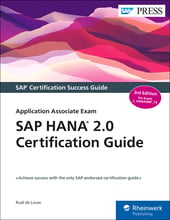When taking the SAP HANA Application Associate certification exam, there are a lot of things you'll be tested on, such as your knowledge of data provisioning with SAP HANA.
That said, here are 19 important SAP HANA data provisioning concepts you'll need to know going into the exam.
- Data provisioning: Get data from a source system and provide that data to a target system.
- Extract, transform, load (ETL): The ETL process consists of the following phases:
- Extraction: Data is read from a source system. Traditional ETL tools can read many data sources, and most can also read data from SAP source systems.
- Transform: Data is transformed. Normally this means cleaning the data, but it can refer to any data manipulation.
- Load: Data is written into the target system.
- Initial load: The process of making a full copy of data from the source system. If we require an entire table, we make a copy of the table in the target system.
- Delta load: Look at the data that has changed, and apply the data changes to the copy of the data in the target system. These data changes are referred to as the delta, and applying these changes to the target system is called a delta load.
- SAP extractors: Read data from a group of tables and deliver the data as a single integrated data unit to the target system.
- Open Database Connectivity (ODBC): ODBC acts as a translation layer between an application and a database via an ODBC driver. Database queries are written using a standard API for accessing database information. The ODBC driver translates these queries to database-specific queries, making your database queries database and operating system independent. By changing the ODBC driver to that of another database and changing your connection information, your application will work with another database.
- Java Database Connectivity (JDBC): JDBC is similar to ODBC but specifically aimed at the Java programming language.
- Object Linking and Embedding, Database for Online Analytical Processing (ODBO): ODBO provides an API for exchanging metadata and data between an application and an OLAP server (e.g., a data warehouse using cubes). You can use this to connect Microsoft Excel to SAP HANA.
- Multidimensional expressions (MDX): MDX is a query language for OLAP databases, similar to how SQL is a query language for relational (OLTP) databases. The MDX standard was adopted by a wide range of OLAP vendors, including SAP.
- Business Intelligence Consumer Services (BICS): BICS is an SAP-proprietary database connection. It’s a direct client connection that performs better and faster than MDX or SQL. Hierarchies are supported, negating the need for MDX in SAP environments. Because this is an SAP-only connection type, you can only use it between two SAP systems, for example, from an SAP reporting tool to SAP BW.
- SAP Data Services: Solution used to integrate, improve the quality of, profile, process, and deliver data.
- SAP Landscape Transformation Replication Server: Uses replication to load data into SAP HANA. Remember that the focus of a replication server is to load data into the target system as fast as possible.
- SAP Replication Server: Uses replication to load data into SAP HANA. SAP Replication Server differs from SAP Landscape Transformation Replication Server in that it uses the database log files for real-time replication. SAP Replication Server reads these database log files to enable table replication. SAP Replication Server replication is also known as log-based replication.
- SAP HANA smart data access (SDA): Provides SAP HANA with direct access to data in a remote database.
- SAP HANA smart data integration (SDI): Uses various adapters to replicate, load, or consume data into SAP HANA.
- SAP HANA smart data quality (SDQ): Used to cleanse and enrich data persisted in the SAP HANA database.
- SAP HANA streaming analytics: Allows you to observe, process, and analyze fast-moving data. You can create continuous projects in Computation Continuous Language (CCL) to model streaming information. You can then issue continuous queries to analyze the data.
- SAP HANA Remote Data Sync (RDSync): Allows you to synchronize data between SAP HANA and thousands of remote SAP SQL Anywhere databases, while still ensuring that you can acquire data for analysis in SAP HANA over intermittent and slow networks.
- SAP Vora: Uses the in-memory technologies that SAP developed with SAP HANA to speed up long-running analytics in Hadoop and Spark clusters.
Studying for the SAP HANA Application Associate exam is important if you want to do well. By learning these 19 SAP HANA data provisioning concepts, you can feel more confident in your database admin knowledge. Good luck on the exam!
Editor’s note: This post has been adapted from a section of the book SAP HANA 2.0 Certification Guide: Application Associate Exam by Rudi de Louw.



Comments